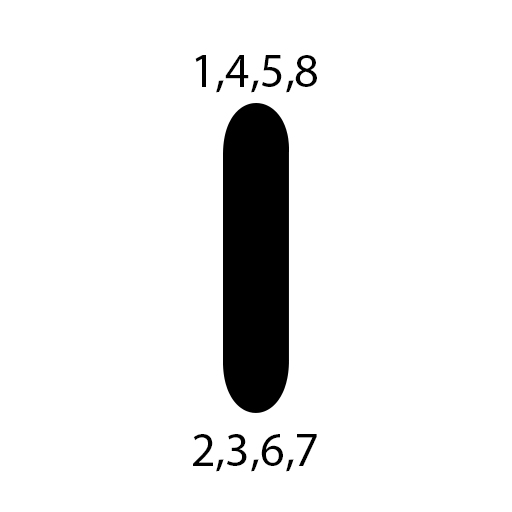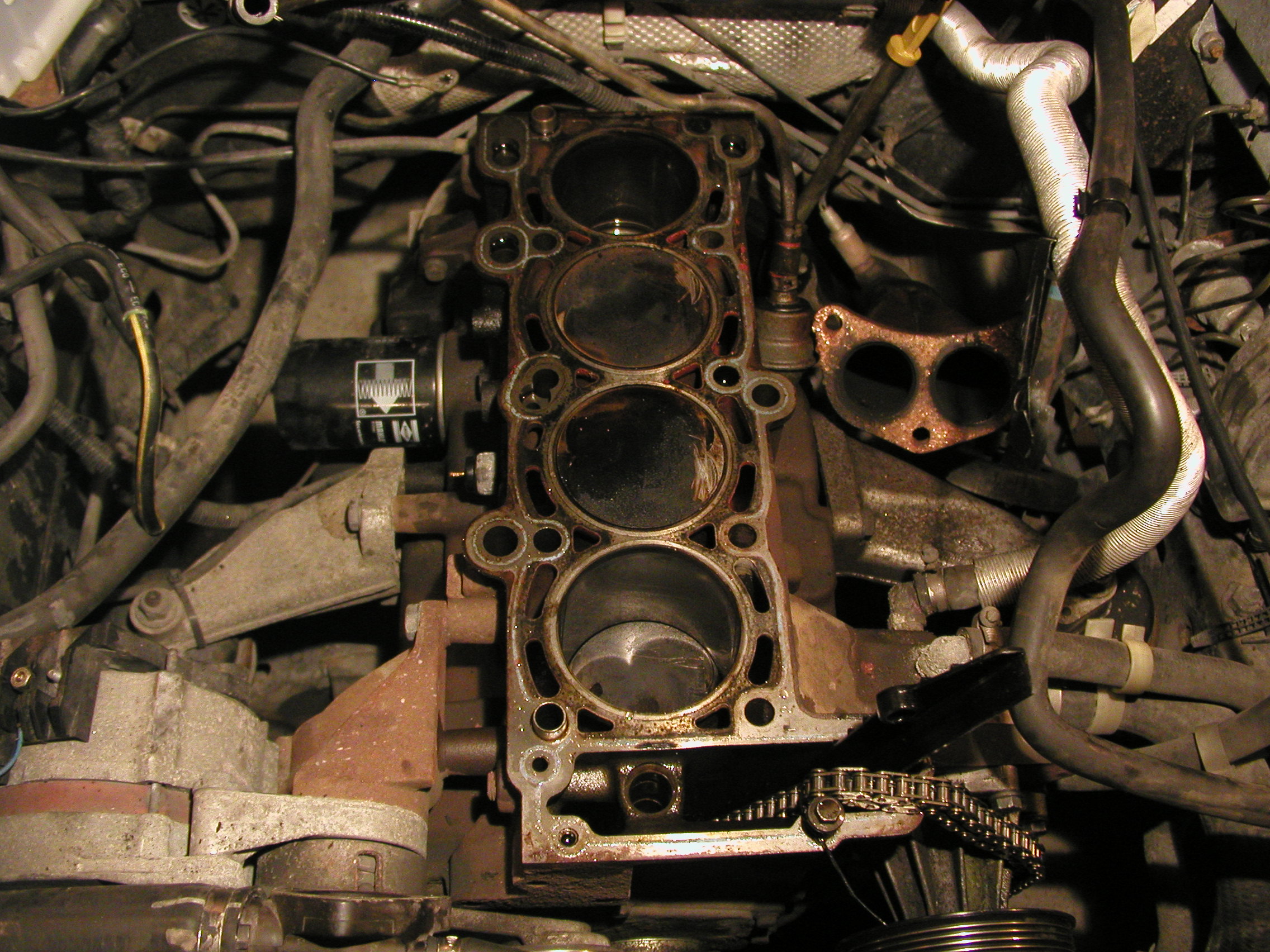|
Crossplane
The crossplane or cross-plane is a crankshaft design for piston engines with a 90° angle (phase in crank rotation) between the crank throws. The crossplane crankshaft is the most popular configuration used in V8 road cars. Aside from the V8 already mentioned, other examples of configurations using such 90° piston phases include straight-2, straight-4, V2, and V4 engines. Crossplane crankshafts could feasibly be used with a great many other cylinder configurations, but the advantages and disadvantages described below may not apply to any or all of them and must be considered on a case-by-case basis. Triumph T-plane Triumph T-plane is a crankshaft design for piston engines with a 270° angle (phase in crank rotation), and T-plane are T shaped crankshaft. The T-plane can be used for inline-3, inline-6 and V6 engines. T-plane use on Triumph Tiger 900 (2020) motorcycle with firing order 180-270-270. T-plane are uneven firing order which similar to Crossplane, but differen ... [...More Info...] [...Related Items...] OR: [Wikipedia] [Google] [Baidu] [Amazon] |
Coventry Climax
Coventry Climax was a British manufacturer of forklift trucks, fire pumps, racing engines, and other speciality engines. History Pre WWI The company was started in 1903 as Lee Stroyer, a joint venture by Jens Stroyer and Pelham Lee. In 1905, following the departure of Stroyer, it was relocated to Paynes Lane, Coventry, and renamed as Coventry Simplex by Horace Pelham Lee, a former Daimler employee, who saw an opportunity in the nascent internal combustion engine market. An early user was GWK, who produced over 1,000 light cars with Coventry-Simplex two-cylinder engines between 1911 and 1915. Just before the First World War, a Coventry-Simplex engine was used by Lionel Martin to power the first Aston Martin car. Ernest Shackleton selected Coventry-Simplex to power the tractors that were to be used in his Imperial Trans-Antarctic Expedition of 1914. Hundreds of Coventry-Simplex engines were manufactured during the First World War to be used in generator sets for se ... [...More Info...] [...Related Items...] OR: [Wikipedia] [Google] [Baidu] [Amazon] |
Flat-plane Crank
The flat-plane crank (sometimes flatplane) is a type of crankshaft for use in internal combustion engines that has a 180-degree angle between crank throws. Details Flat-plane cranks are used in V-configuration engines, generally with eight cylinders. Cadillac introduced a V8 flat-plane crank engine in 1923. Inline-four cylinder engines almost all use flat-plane cranks, and thus are not usually identified as such. However, there are a few exceptions with crossplane cranks. The flat-plane crankshaft was used in the World War II Sherman Tank in the Ford GAA engine, an all-aluminium 32-valve DOHC 60-degree liquid-cooled V8. However, the flat-plane design is no longer widely used in most mass production V engines as it is more prone to vibration and is inherently much louder than a crossplane crankshaft. However, due to its simpler construction requiring less counterweight, it is inherently lighter with a higher rev limit. For this reason, it remains useful in sports ... [...More Info...] [...Related Items...] OR: [Wikipedia] [Google] [Baidu] [Amazon] |
Flatplane
The flat-plane crank (sometimes flatplane) is a type of crankshaft for use in internal combustion engines that has a 180-degree angle between crank throws. Details Flat-plane cranks are used in V engines, V-configuration engines, generally with eight cylinders. Cadillac introduced a V8 flat-plane crank engine in 1923. Inline-four cylinder engines almost all use flat-plane cranks, and thus are not usually identified as such. However, there are a few Crossplane#Inline-four_crossplane_crankshaft, exceptions with crossplane cranks. The flat-plane crankshaft was used in the World War II Sherman Tank in the Ford GAA engine, an all-aluminium 32-Poppet valve, valve Overhead camshaft, DOHC 60-degree liquid-cooled V8. However, the flat-plane design is no longer widely used in most mass production V engines as it is more prone to vibration and is inherently much louder than a crossplane crankshaft. However, due to its simpler construction requiring less counterweight, it is inher ... [...More Info...] [...Related Items...] OR: [Wikipedia] [Google] [Baidu] [Amazon] |
V6 Engine
A V6 engine is a six- cylinder piston engine where the cylinders and cylinder blocks share a common crankshaft and are arranged in a V configuration. The first V6 engines were designed and produced independently by Marmon Motor Car Company, Deutz Gasmotoren Fabrik and Delahaye. Engines built after World War II include the Lancia V6 engine in 1950 for the Lancia Aurelia, and the Buick V6 engine in 1962 for the Buick Special. The V6 layout has become the most common layout for six-cylinder automotive engines. Design Due to their short length, V6 engines are often used as the larger engine option for vehicles which are otherwise produced with inline-four engines, especially in transverse engine vehicles. A downside for luxury cars is that V6 engines produce more vibrations than straight-six engines. Some sports cars like the Porsche 911 use flat-six engines instead of V6 engines, due to their near perfect primary engine balance and lower centre of gravity (which ... [...More Info...] [...Related Items...] OR: [Wikipedia] [Google] [Baidu] [Amazon] |
Inline-four Engine
A straight-four engine (also referred to as an inline-four engine) is a four-cylinder piston engine where cylinders are arranged in a line along a common crankshaft. The majority of automotive four-cylinder engines use a straight-four layout (with the exceptions of the flat-four engines produced by Subaru and Porsche) and the layout is also very common in motorcycles and other machinery. Therefore the term "four-cylinder engine" is usually synonymous with straight-four engines. When a straight-four engine is installed at an inclined angle (instead of with the cylinders oriented vertically), it is sometimes called a slant-four. Between 2005 and 2008, the proportion of new vehicles sold in the United States with four-cylinder engines rose from 30% to 47%. By the 2020 model year, the share for light-duty vehicles had risen to 59%. Design A four-stroke straight-four engine always has a cylinder on its power stroke, unlike engines with fewer cylinders where there is no power st ... [...More Info...] [...Related Items...] OR: [Wikipedia] [Google] [Baidu] [Amazon] |
Crankshaft
A crankshaft is a mechanical component used in a reciprocating engine, piston engine to convert the reciprocating motion into rotational motion. The crankshaft is a rotating Shaft (mechanical engineering), shaft containing one or more crankpins, that are driven by the pistons via the connecting rods. The crankpins are also called ''rod bearing journals'', and they rotate within the "big end" of the connecting rods. Most modern crankshafts are located in the engine block. They are made from steel or cast iron, using either a forging, casting (metalworking), casting or machining process. Design The crankshaft is located within the engine block and held in place via main bearings which allow the crankshaft to rotate within the block. The up-down motion of each piston is transferred to the crankshaft via connecting rods. A flywheel is often attached to one end of the crankshaft, in order to smoothen the power delivery and reduce vibration. A crankshaft is subjected to enormou ... [...More Info...] [...Related Items...] OR: [Wikipedia] [Google] [Baidu] [Amazon] |
Cylinder (engine)
In an engine, the cylinder is the space in which a piston travels. The inner surface of the cylinder is formed from either a thin metallic liner (also called "sleeve") or a surface coating applied to the engine block. A piston is seated inside each cylinder by several metal piston rings, which also provide seals for compression and the lubricating oil. The piston rings do not actually touch the cylinder walls, instead they ride on a thin layer of lubricating oil. Steam engines The cylinder in a steam engine is made pressure-tight with end covers and a piston; a valve distributes the steam to the ends of the cylinder. Cylinders were cast in cast iron and later in steel. The cylinder casting can include other features such as valve ports and mounting feet. Internal combustion engines The cylinder is the space through which the piston travels, propelled by the energy generated from the combustion of the air/fuel mixture in the combustion chamber. In an air-cooled e ... [...More Info...] [...Related Items...] OR: [Wikipedia] [Google] [Baidu] [Amazon] |
BRM P261
The BRM P261, also known as the BRM P61 Mark II, is a Formula One motor racing car, designed and built by the British Racing Motors team in Bourne, Lincolnshire, Bourne, Lincolnshire, England. The BRM P261 was introduced for the 1964 Formula One season, and its design was an evolution of Tony Rudd's one-off BRM P61 car of . The P261 had a relatively long racing career; variants of the car were still being entered for Formula One World Championship Grands Prix as late as . During the course of their front-line career, BRM P261s won six World Championship races, in the hands of works drivers Graham Hill and Jackie Stewart, and finished second in both the Drivers' and Constructors' Championship standings in 1964 and . Stewart, Hill and Richard Attwood also used works P261s to compete in the Tasman Series in 1966. The BRMs dominated, with Stewart winning four, Hill two, and Attwood one of the 1966 Tasman Series' eight races.''New Zealand Motor Racing'' Stewart also won the title. The wo ... [...More Info...] [...Related Items...] OR: [Wikipedia] [Google] [Baidu] [Amazon] |
British Racing Motors
British Racing Motors (BRM) was a British Formula One motor racing team. Founded in 1945 and based in the market town of Bourne, Lincolnshire, Bourne in Lincolnshire, it participated from 1951 to 1977, competing in 197 Grand Prix motor racing, grands prix and winning seventeen. BRM won the constructors' title in 1962 when its driver Graham Hill became world champion. In 1963, 1964, 1965 and 1971, BRM came second in the constructors' competition. History BRM was founded just after the World War II, Second World War by Raymond Mays, who had built several Hillclimbing, hillclimb and road racing cars under the English Racing Automobiles, ERA brand before the war, and Peter Berthon, a long-time associate. Mays' pre-war successes (and access to pre-war Mercedes-Benz and Auto Union design documents) inspired him to build an all-British grand prix car for the post-war era as a national prestige project, with financial and industrial backing from the British motor industry and its su ... [...More Info...] [...Related Items...] OR: [Wikipedia] [Google] [Baidu] [Amazon] |





